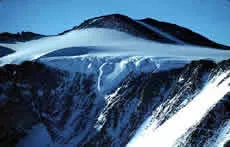Cryosphere glossary
the coordinated global system of telecommunication facilities and arrangements for the rapid collection, exchange and distribution of observational data in the framework of the World Weather Watch, a World Meteorological Organization program.
the same as geostrophic wind, but blowing parallel to curved isobars or contours; the curved airflow pattern around a pressure center results from a balance among pressure-gradient force, coriolis force, and centrifugal force.
a distinct soil micromorphology, resulting from the effects of freezing and thawing processes, in which soil particles form discrete loosely packed units.
a distinct soil micromorphology, resulting from the effects of freezing and thawing processes, in which soil particles form more or less discrete loosely packed units.
snowflakes that become rounded pellets due to riming; typical sizes are 2 to 5 millimeters in diameter (0.1 to 0.2 inch); graupel is sometimes mistaken for hail.
the ratio of the mass of the water and ice in a sample to the dry mass of the sample, commonly expressed as a percentage.
a wave disturbance in which buoyancy (or reduced gravity) acts as a restoring force on parcels displaced from hydrostatic equilibrium; there is a direct oscillatory conversion between potential and kinetic energy in the wave motion.
a very thin, soupy layer of frazil crystals clumped together, which makes the ocean surface resemble an oil slick.
Image

Grease ice (thin, light-grey area) with thick ice floes.
Ted Maksym, United States Naval Academy
the anticyclone that appears to overlie Greenland; analogous to the antarctic anticyclone.
a category of young ice 15 to 30 centimeters (6 to 12 inches) thick, named for its color.
Image

Thin grey-white ice showing the effects of ridging and rafting.
Antarctic Sea-Ice Processes and Climate program (ASPeCt)
a finite collection of points to which the meteorological variables used in a numerical model, or interpolated from observations, apply; a field of such regular values (points) is termed gridded field.
an iceberg less than 2 meters (6.6 feet) across that floats with less than 1 meter (3.3 feet) showing above water; smaller than a bergy bit.
precipitation of small balls or pieces of ice (hailstones) with a diameter ranging from 5 to 50 millimeters (0.2 to 2.0 inches), or sometimes bigger, falling either separately or agglomerated into irregular lumps; when the diameter is less than about 5 millimeters (0.2 inch), the balls are called ice pellets.
group of optical phenomena, in the form of rings, arcs, pillars or bright spots around the sun or moon, produced by the refraction or reflection of light by ice crystals suspended in the atmosphere (cirrus clouds, diamond dust, etc.).
a valley formed by a small glacier that has a valley bottom relatively higher than nearby valleys formed by larger glaciers.
